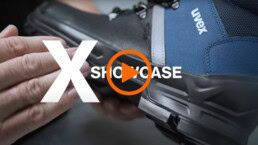Safety shoes are extremely important on construction sites to protect workers from hazards such as falling objects, sharp edges, pointed nails and slippery surfaces. Construction site safety shoes provide necessary foot protection while increasing comfort to make daily work easier. As harsh conditions prevail on construction sites, safety shoes for construction sites must meet requirements such as water impermeability, puncture resistance and slip-resistant soles. uvex stands for competent and ergonomic protective equipment that minimises the risk of accidents at work. The following article is aimed at employers who equip their employees with safety footwear and require information on guidelines and protection classes.
When do safety shoes for construction sites fulfil the requirements?
Work shoes for construction sites are part of personal protective equipment (PPE) and must fulfil a variety of requirements to ensure the protection and comfort of employees. The basic protective functions include
- Toe protection
- Puncture protection
- Slip-resistant soles
These features protect against mechanical hazards. The safety classes for safety shoes (S1, S2, S3) and the standards of EN ISO 20345 define the minimum requirements that a safety shoe must fulfil.
What protection class is required for safety footwear for construction sites?
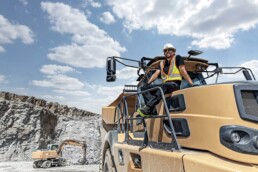
Safety class S3 shoes are generally required on construction sites, as they offer comprehensive protection, fulfil the necessary safety functions and are also suitable for outdoor use in wet conditions.
Safety shoes on the construction site: Which class you need depends on the specific hazards and requirements of the construction project in question. For example, construction workers working in damp environments or operating dangerous machinery may benefit from S3 class safety footwear, while construction workers in less hazardous areas may be well equipped with S1 or S2 class footwear.
If you are not sure which construction site footwear is best suited to your work, a safety footwear product consultation can help you choose the right footwear.
What does S1, S2, S3 mean for safety footwear for construction sites?
The different protection classes stipulate that safety shoes for the construction site must fulfil certain requirements. For the individual protection classes, this means
S1 safety shoes:
- Protective toe cap that can withstand an energy of at least 200 joules
- Antistatic properties
- Energy absorption in the heel area
- Slip-resistant sole
- Not water-repellent
- Not puncture-resistant
S2 safety shoes:
- All functions of S1
- Water-repellent
- Additional protection in wet conditions (for outdoor work)
S3 safety shoes:
- All functions of S2
- Penetration protection
- Water resistant
- Fuel resistant: These safety shoes are resistant to oil, chemicals and industrial substances.
Are safety shoes compulsory on the construction site?
Yes, safety shoes are compulsory on construction sites. In Germany, they are required by law to ensure the safety of employees. The obligation arises from the Occupational Health and Safety Act and the occupational health and safety regulations, such as the Construction Site Ordinance and the General Accident Prevention Regulations.
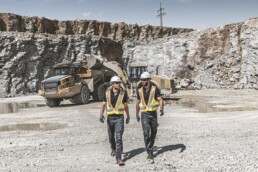
One of the main reasons for this obligation is to protect against injuries: There are numerous sources of danger on construction sites that can lead to serious injuries without suitable foot protection, such as falling building materials, sharp objects on the floor or damp and slippery surfaces.
These specific regulations apply to safety shoes in the construction industry
In Germany, the Employer's Liability Insurance Association for the Construction Industry (BG BAU) stipulates that construction workers on building sites must wear at least class S3 safety shoes if they come into contact with potential hazards such as sharp objects, heavy loads or chemical substances.
What special requirements does this harsh working environment bring for footwear?
The harsh working environment on construction sites brings particularly high demands on footwear, as construction workers are exposed to numerous hazards during their work. These hazards require safety footwear for construction sites to have special features and functions to ensure safety and comfort. The most important requirements for safety footwear on construction sites are
- Protection against mechanical hazards
- Slip-resistant sole
- Water resistance
- Comfort and ergonomics
- Stability and protection of the heel area
- Chemical resistance
- Flexibility and freedom of movement
- Durability and abrasion resistance
- Closure mechanism and adaptability
- Innovations
The last bullet point includes additional requirements such as anti-slip pads, breathable materials and the weight class of the shoes.
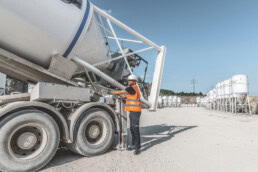
What dangers exist on construction sites?
Safety shoes for construction sites are not only mandatory, but also make an effective contribution to occupational safety. There are many dangers on construction sites, such as falling objects, trapping or crushing of feet by machines, vehicles or scaffolding. There are also often sharp or pointed objects on the floor, such as nails, screws or cutter knife blades, which could possibly penetrate the foot. Foot injuries can also be caused by rolling or tipping loads. It is not uncommon for the floor to be uneven or even slippery or for cables, pipes or tools to be a real tripping hazard. There is also the risk of falling from ladders or scaffolding. Other potential hazards:
- Chemical: toxic or corrosive substances such as concrete, cement, paints, solvents or adhesives.
- Thermal: hot surfaces or liquids such as in asphalt construction and extreme weather conditions.
- Machine movement: Construction site vehicles such as excavators, cranes and lorries.
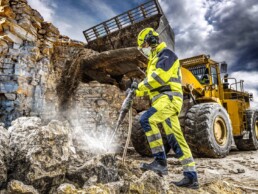
What injuries should be avoided?
By wearing work shoes, you minimise possible foot injuries. The most common injuries related to safety footwear for construction are many and varied. These include crush injuries, puncture injuries, sprains and fractures, burns and chemical burns, electric shock and long-term foot problems due to fatigue and misalignment. To ensure that you don’t have to experience these injuries in the first place, pay attention to the corresponding protection classes when buying safety shoes for construction.
What functions do good safety shoes for the construction site have?
Good safety shoes for the construction site must fulfil a number of functions in order to provide optimum protection for the feet and at the same time offer a high level of comfort.
Protective functions:
- Protective toe cap made of steel or plastic
- Penetration protection
- Slip resistance
- Shock absorption to relieve the joints and reduce fatigue.
- Heat resistance for working in extreme temperatures
Resistance to external influences:
- Protection against moisture
- Resistance to oil, petrol and chemicals
- Insulation against cold
- Abrasion-resistant materials for longer durability
Comfort and ergonomics:
- Breathable materials
- Low weight for less fatigue
- Optimised fit and cushioning
- Flexible sole for easier kneeling
- Shock-absorbing midsole for additional comfort
Practical additional functions:
- Lacing: BOA Fit System and quick lacing system
- ESD protection (electrostatic discharge)
- Reflective elements for better visibility in the dark
- Antibacterial interior for better hygiene
What safety shoes does uvex offer for the construction site? With which features?
uvex offers a range of safety shoes for men and women who work on construction sites or on rough terrain. Here are some models with their main features:
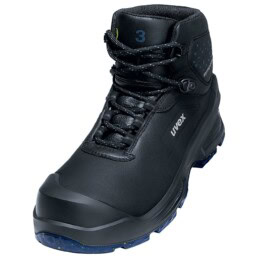
This safety shoe is equipped with a robust MACSOLE sole that offers excellent slip and abrasion resistance. The upper is made of high-quality leather, which guarantees durability and protection. The shoe complies with protection class S3. It is antistatic, has a puncture-resistant sole, a protective toe cap and is water-repellent. The ergonomic design also ensures a high level of comfort, even during long working days on the construction site. The uvex 3 MACSOLE is also available with the practical Boa® Fit System. The twist fastener ensures that the fit can be adjusted quickly and effortlessly.
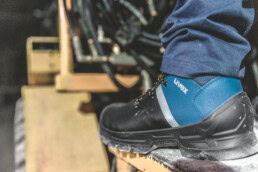
Specially developed for the requirements on construction sites, this safety shoe offers a combination of safety and comfort. Its upper material is particularly resistant to external influences and the sole ensures excellent slip resistance on various surfaces.
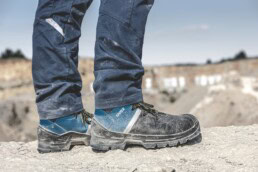
The uvex 2 construction fulfils all the requirements of protection class S3 and is therefore ideal for use in the construction industry. A special feature is the optimised cushioning in the heel area, which increases wearer comfort and prevents signs of fatigue.
This model is specially designed for use in road and asphalt construction. The shoe has a heat-resistant sole that can withstand temperatures of up to 300 °C and a hard-wearing upper that protects against hot materials.
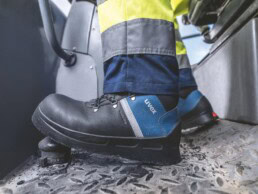
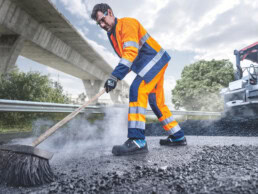
The S3 protection category guarantees comprehensive protection, including puncture protection and toe protection. The sole is also designed so that it leaves no marks on fresh tarmac, which is particularly beneficial in road construction.
uvex 3 quatro
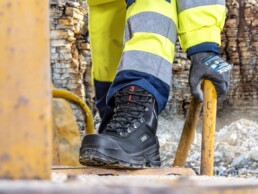
The uvex 3 quatro is a robust safety shoe that has been developed for demanding applications on rough construction sites and in harsh industrial environments. The upper material is made of hard-wearing full-grain leather, which is reinforced with an additional PU layer on the heel and the GRP toe cap. The high-quality sole technology ensures safe steel penetration resistance and comfortable shock absorption, which offers improved energy return. The shoe complies with protection class S3. Thanks to innovative technology and optimised design, the uvex 3 quatro ensures maximum comfort, even on long working days. The seams are equipped with reflective details that increase visibility and thus contribute to safety.
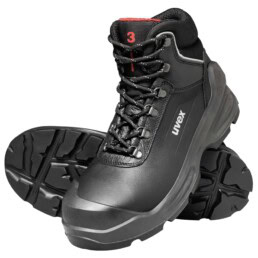
The uvex 3 quatro will be available in the uvex B2B online shop from May. If you would like to get an idea of our new footwear all-rounder before then, please visit us at bauma in Munich! From 7 to 13 April, we will have the model available to try on in all standard sizes at stand B4.302.
If you are interested in one of the latest safety shoes, you are welcome to use our product advice page for safety shoes. You can be sure that the models fully meet the high requirements on construction sites.
